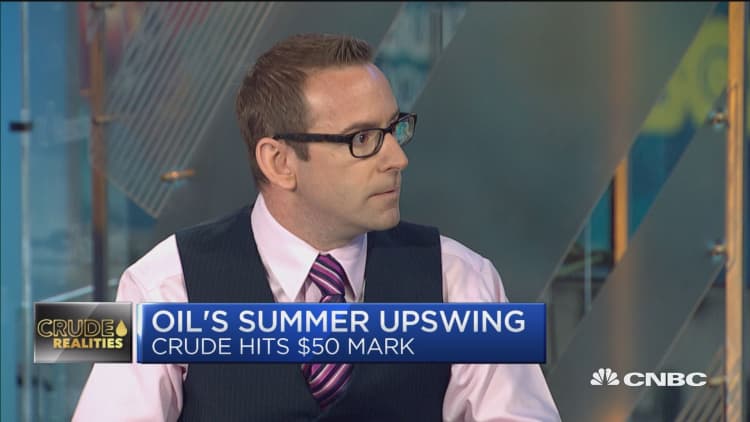Oil prices fell on Thursday, turning negative as cautious buying dried up after U.S. crude rose to nearly $50 a barrel.
U.S. West Texas Intermediate (WTI) crude futures ended Thursday's session down 56 cents, or 1.1 percent, $49.03 per barrel, after earlier rising as high as $49.96.
Brent crude futures, the international benchmark for oil prices, were trading down 35 cents at $52.01 per barrel at 2:29 p.m. (1829 GMT). The contract nearly set a 10-week intraday high earlier in the session.
Concern about high crude supplies from producer club OPEC offset the previous day's data showing record U.S. gasoline demand.

Strong demand in the United States has been supporting prices. The U.S. Energy Information Administration reported record gasoline demand of 9.84 million barrels per day (bpd) for last week, and a fall in commercial crude inventories of 1.5 million barrels to 481.9 million barrels.
That's below levels seen this time last year, an indication of a tightening U.S. market.
"Five weeks of crude draws is lending some credence to the idea that the OPEC cut is beginning to impact the market," said Gene McGillian, manager of market research at Tradition Energy in Stamford.
Still, U.S. light crude has been capped by robust domestic supplies.
"The market needs continuing signs of improvement in the inventory picture to really drive the prices higher," he said.
But traders say high production by the Organization of the Petroleum Exporting Countries is capping prices.
OPEC and other producers including Russia have promised to restrict output by 1.8 million bpd until March 2018 to help support prices and draw down inventories.
Yet OPEC output hit a 2017 high of 33 million bpd in July, up 90,000 bpd from the previous month, a Reuters survey showed earlier this week, led by a further recovery in supply from Libya, one of the countries exempt from a production-cutting deal.

Ample supply is likely to keep a lid on prices, many analysts say.
"Our view of the oil market is that a major rally is unlikely in 2017," National Australia Bank analysts said in a note to clients. "Absent further production cuts or a sustained uptick in demand, prices are likely to remain in the low to mid $50s for the remainder of the year."
There are signs that the oil industry has adapted to an era of low prices and can produce and operate at levels that would previously have been uneconomic.
"Of the major projects sanctioned by the big five oil companies (ExxonMobil, Royal Dutch Shell, Chevron, BP and Total) over H1 2017, there has been a clear breakeven target price of $40 per barrel or lower at offshore oil projects," BMI Research said.
U.S. investment bank Goldman Sachs said this week that the oil industry had successfully adapted to oil prices around $50 per barrel.

